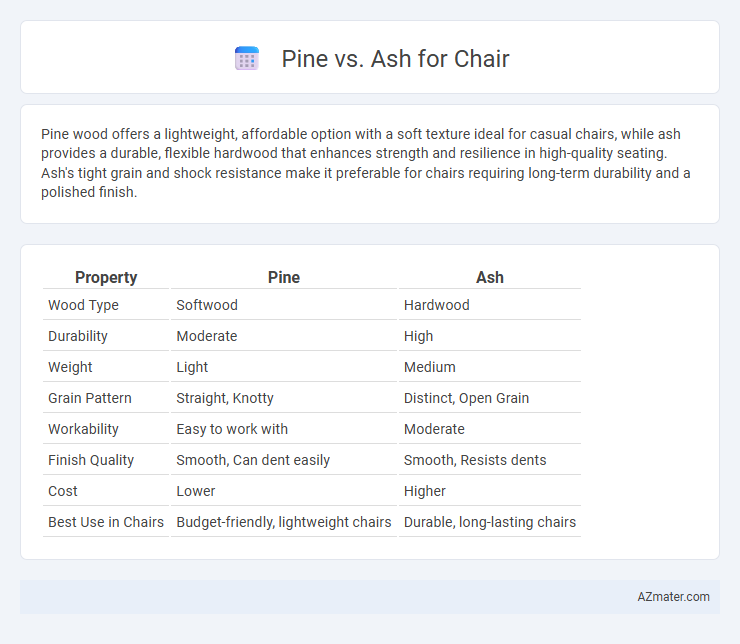Pine wood offers a lightweight, affordable option with a soft texture ideal for casual chairs, while ash provides a durable, flexible hardwood that enhances strength and resilience in high-quality seating. Ash's tight grain and shock resistance make it preferable for chairs requiring long-term durability and a polished finish.
Table of Comparison
| Property | Pine | Ash |
|---|---|---|
| Wood Type | Softwood | Hardwood |
| Durability | Moderate | High |
| Weight | Light | Medium |
| Grain Pattern | Straight, Knotty | Distinct, Open Grain |
| Workability | Easy to work with | Moderate |
| Finish Quality | Smooth, Can dent easily | Smooth, Resists dents |
| Cost | Lower | Higher |
| Best Use in Chairs | Budget-friendly, lightweight chairs | Durable, long-lasting chairs |
Introduction to Pine and Ash Wood
Pine wood, known for its light color and soft texture, offers affordability and ease of shaping, making it a popular choice for chair construction. Ash wood features a durable, hard surface with prominent grain patterns, providing both strength and an attractive aesthetic suited for long-lasting furniture. Comparing pine and ash highlights pine's cost-effectiveness and lightness against ash's superior durability and striking appearance in chair design.
Key Characteristics of Pine Wood
Pine wood is lightweight, soft, and features a pale yellow color with distinct knots, making it easy to work with and ideal for rustic or casual chair designs. Its grain is straighter and more uniform compared to ash, but pine is less durable and more prone to dents and scratches. Pine is also more affordable and readily available, making it a popular choice for budget-friendly and decorative chair projects.
Key Characteristics of Ash Wood
Ash wood is valued in chair making for its exceptional strength, durability, and flexibility, making it ideal for supporting weight and withstanding wear. Its straight grain and light color provide a smooth finish and aesthetic appeal, often preferred over pine's softer, more knot-prone texture. Ash also offers better shock resistance and longevity, enhancing the overall structural integrity and comfort of chairs.
Strength and Durability Comparison
Ash wood exhibits superior strength and durability compared to pine, making it a preferred choice for sturdy chair construction. Its dense grain structure provides excellent resistance to wear and impact, ensuring long-lasting performance under regular use. Pine, while lighter and more affordable, is softer and more prone to dents and scratches, resulting in lower overall durability for chairs.
Appearance and Grain Patterns
Pine chairs display a light, creamy color with straight, subtle grain patterns and occasional knots, offering a rustic and warm aesthetic. Ash chairs feature a pale beige to light brown hue with pronounced, distinctive grain patterns that are often wavy or curly, providing a more refined and dynamic visual texture. The contrast between pine's softer grain and ash's bold, intricate patterns significantly impacts the chair's overall style and visual appeal.
Workability and Ease of Crafting
Pine offers superior workability due to its softness and light weight, making it easier to cut, shape, and sand for chair construction. Ash, while harder and denser, provides better durability but requires more effort and sharper tools for crafting detailed designs. Both woods are popular for chairs, but pine's ease of handling makes it ideal for beginner woodworkers and quick projects.
Weight and Mobility
Pine chairs are generally lighter than ash chairs, making them easier to move and ideal for flexible seating arrangements. Ash wood is denser and heavier, which provides greater stability but reduces overall mobility. For environments requiring frequent rearrangement, pine is preferred due to its lightweight properties, while ash is better suited for stationary, durable furniture.
Cost and Availability
Pine chairs are generally more affordable and widely available due to the fast growth and abundance of pine trees, making it a budget-friendly choice for furniture. Ash wood, while slightly more expensive, offers greater durability and a more refined grain, leading to higher cost but limited availability compared to pine. Availability of ash can fluctuate regionally, influencing both price and purchasing options for quality chair construction.
Best Uses: Pine vs Ash for Different Chair Styles
Pine is ideal for rustic and casual chair styles due to its soft texture and affordability, making it perfect for farmhouse and cottage designs. Ash offers greater strength and durability, suitable for more refined, modern, or traditional chair styles that require enhanced support and a smooth finish. Pine suits lightweight, decorative chairs, while ash excels in crafting sturdy dining and office chairs that demand longevity.
Final Verdict: Choosing Between Pine and Ash for Chairs
Ash wood offers superior durability and strength, making it ideal for high-traffic chairs that require long-lasting support, while pine is softer and more affordable, perfect for lightweight or decorative chair designs. Pine's natural light color and ease of staining provide versatile aesthetic options, whereas ash's tight grain and rich tones offer a more refined and classic appearance. For chairs demanding robust construction and elegant finish, ash is the preferred choice, but pine remains a budget-friendly option for casual or rustic furniture.

Infographic: Pine vs Ash for Chair
 azmater.com
azmater.com